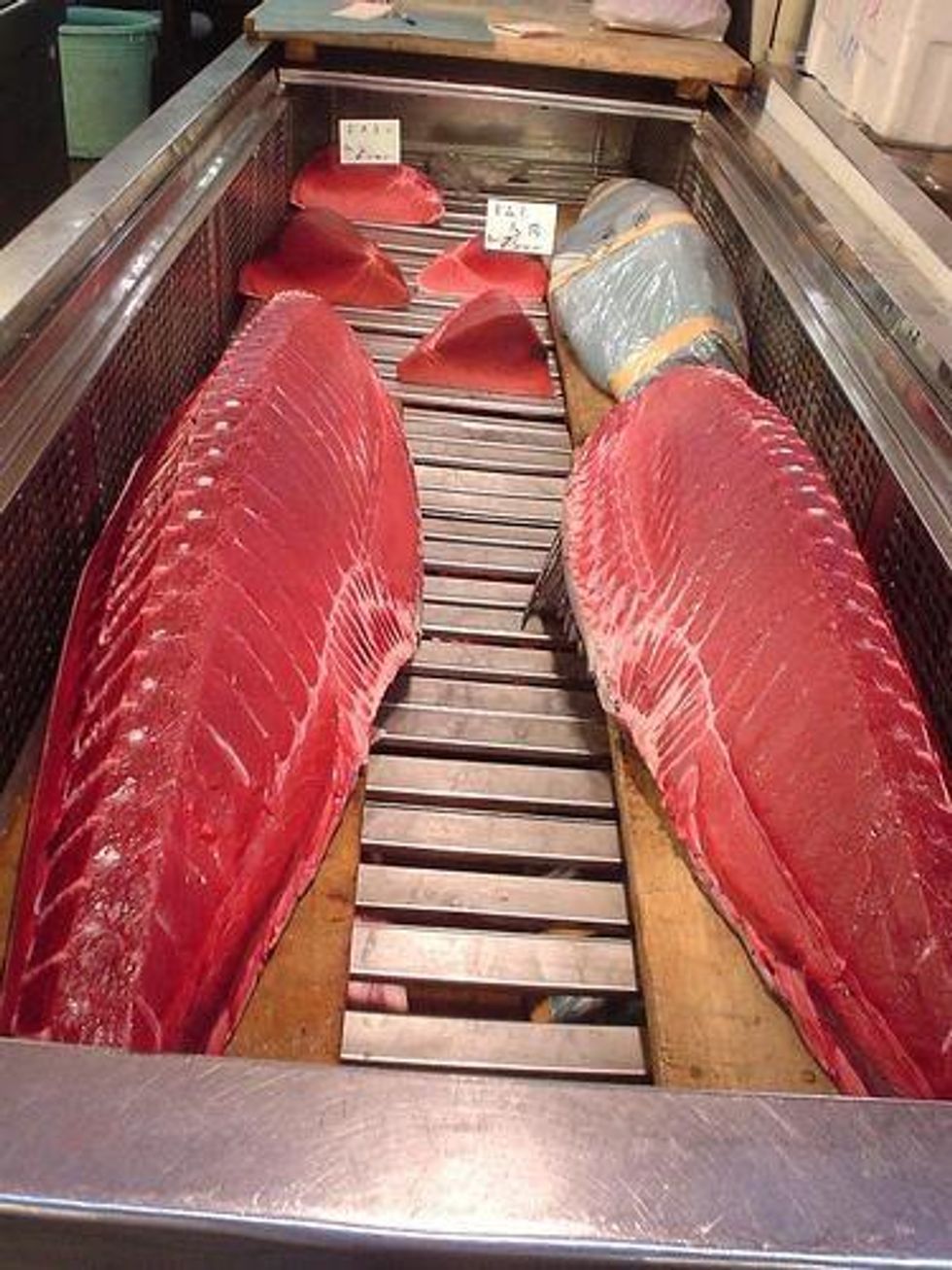Nuclear Tuna and NPR's Trivialization
NPR shouldn't trivialize the risk of radioactive tuna from the Fukushima nuclear disaster.
Yesterday, National Public Radio (NPR) ran a story asserting that cesium-137 from the Fukushima nuclear accident found in Bluefish tuna on the west coast of the U.S. is harmless.

It's not harmless. The Fukushima nuclear accident released about as much cesium-137 as a thermonuclear weapon with the explosive force of 11 million tons of TNT. In the spring of 1954, after the United States exploded nuclear weapons in the Marshall Islands, the Japanese government had to confiscate about 4 million pounds of contaminated fish.
Radiation from Fukushima spread far and wide. Like American hydrogen bomb testing, the Fukushima nuclear accident deposited cesium-137 over 600,000 square-miles of the Pacific, as well as the Northern Hemisphere and Europe. With a half-life of 30 years, cesium-137 is taken up in the meat of the tuna as if it were potassium, indicating that the metabolism holds on to it.
According to a previously secret 1955 memo from the U.S. Atomic Energy Commission regarding concerns of the British government over contaminated tuna, "dissipation of radioactive fall-out in ocean waters is not a gradual spreading out of the activity from the region with the highest concentration to uncontaminated regions, but that in all probability the process results in scattered pockets and streams of higher radioactive materials in the Pacific. We can speculate that tuna which now show radioactivity from ingested materials have been living, in or have passed through, such pockets; or have been feeding on plant and animal life which has been exposed in those areas."
In 2001, the U.S. Agency for Toxic Substances Disease Registry noted that "...concentrations of cesium within muscle tissue are somewhat higher than the whole-body average. Cesium has been shown to cross the placental barrier of animals..."
There are several reasons why it's not advisable to eat Bluefin tuna:
- Cesium-137 adds to the contaminant risk of harm to humans eating the Bluefin tuna, especially pregnant women and infants, who are the most vulnerable, and will for some time to come.
- Bluefin tuna is an endangered species because of over-fishing and contamination.
- Bluefin tuna accumulate other contaminants such as mercury from sources such as coal-fired power plants.
If NPR had been around in the 1950's, would it also have trivialized the impacts of open-air hydrogen bomb testing?
An Urgent Message From Our Co-Founder
Dear Common Dreams reader, The U.S. is on a fast track to authoritarianism like nothing I've ever seen. Meanwhile, corporate news outlets are utterly capitulating to Trump, twisting their coverage to avoid drawing his ire while lining up to stuff cash in his pockets. That's why I believe that Common Dreams is doing the best and most consequential reporting that we've ever done. Our small but mighty team is a progressive reporting powerhouse, covering the news every day that the corporate media never will. Our mission has always been simple: To inform. To inspire. And to ignite change for the common good. Now here's the key piece that I want all our readers to understand: None of this would be possible without your financial support. That's not just some fundraising cliche. It's the absolute and literal truth. We don't accept corporate advertising and never will. We don't have a paywall because we don't think people should be blocked from critical news based on their ability to pay. Everything we do is funded by the donations of readers like you. Will you donate now to help power the nonprofit, independent reporting of Common Dreams? Thank you for being a vital member of our community. Together, we can keep independent journalism alive when it’s needed most. - Craig Brown, Co-founder |
Yesterday, National Public Radio (NPR) ran a story asserting that cesium-137 from the Fukushima nuclear accident found in Bluefish tuna on the west coast of the U.S. is harmless.

It's not harmless. The Fukushima nuclear accident released about as much cesium-137 as a thermonuclear weapon with the explosive force of 11 million tons of TNT. In the spring of 1954, after the United States exploded nuclear weapons in the Marshall Islands, the Japanese government had to confiscate about 4 million pounds of contaminated fish.
Radiation from Fukushima spread far and wide. Like American hydrogen bomb testing, the Fukushima nuclear accident deposited cesium-137 over 600,000 square-miles of the Pacific, as well as the Northern Hemisphere and Europe. With a half-life of 30 years, cesium-137 is taken up in the meat of the tuna as if it were potassium, indicating that the metabolism holds on to it.
According to a previously secret 1955 memo from the U.S. Atomic Energy Commission regarding concerns of the British government over contaminated tuna, "dissipation of radioactive fall-out in ocean waters is not a gradual spreading out of the activity from the region with the highest concentration to uncontaminated regions, but that in all probability the process results in scattered pockets and streams of higher radioactive materials in the Pacific. We can speculate that tuna which now show radioactivity from ingested materials have been living, in or have passed through, such pockets; or have been feeding on plant and animal life which has been exposed in those areas."
In 2001, the U.S. Agency for Toxic Substances Disease Registry noted that "...concentrations of cesium within muscle tissue are somewhat higher than the whole-body average. Cesium has been shown to cross the placental barrier of animals..."
There are several reasons why it's not advisable to eat Bluefin tuna:
- Cesium-137 adds to the contaminant risk of harm to humans eating the Bluefin tuna, especially pregnant women and infants, who are the most vulnerable, and will for some time to come.
- Bluefin tuna is an endangered species because of over-fishing and contamination.
- Bluefin tuna accumulate other contaminants such as mercury from sources such as coal-fired power plants.
If NPR had been around in the 1950's, would it also have trivialized the impacts of open-air hydrogen bomb testing?
Yesterday, National Public Radio (NPR) ran a story asserting that cesium-137 from the Fukushima nuclear accident found in Bluefish tuna on the west coast of the U.S. is harmless.

It's not harmless. The Fukushima nuclear accident released about as much cesium-137 as a thermonuclear weapon with the explosive force of 11 million tons of TNT. In the spring of 1954, after the United States exploded nuclear weapons in the Marshall Islands, the Japanese government had to confiscate about 4 million pounds of contaminated fish.
Radiation from Fukushima spread far and wide. Like American hydrogen bomb testing, the Fukushima nuclear accident deposited cesium-137 over 600,000 square-miles of the Pacific, as well as the Northern Hemisphere and Europe. With a half-life of 30 years, cesium-137 is taken up in the meat of the tuna as if it were potassium, indicating that the metabolism holds on to it.
According to a previously secret 1955 memo from the U.S. Atomic Energy Commission regarding concerns of the British government over contaminated tuna, "dissipation of radioactive fall-out in ocean waters is not a gradual spreading out of the activity from the region with the highest concentration to uncontaminated regions, but that in all probability the process results in scattered pockets and streams of higher radioactive materials in the Pacific. We can speculate that tuna which now show radioactivity from ingested materials have been living, in or have passed through, such pockets; or have been feeding on plant and animal life which has been exposed in those areas."
In 2001, the U.S. Agency for Toxic Substances Disease Registry noted that "...concentrations of cesium within muscle tissue are somewhat higher than the whole-body average. Cesium has been shown to cross the placental barrier of animals..."
There are several reasons why it's not advisable to eat Bluefin tuna:
- Cesium-137 adds to the contaminant risk of harm to humans eating the Bluefin tuna, especially pregnant women and infants, who are the most vulnerable, and will for some time to come.
- Bluefin tuna is an endangered species because of over-fishing and contamination.
- Bluefin tuna accumulate other contaminants such as mercury from sources such as coal-fired power plants.
If NPR had been around in the 1950's, would it also have trivialized the impacts of open-air hydrogen bomb testing?

